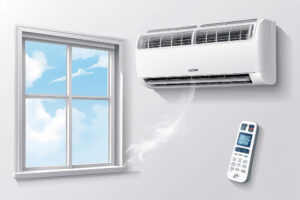Air conditioning has always been a polarizing subject when it comes to environmental friendliness. While it is accurate to say that air conditioning systems often have a substantial environmental effect, this is especially true of the older and larger systems. Air conditioning is getting more ecologically friendly, However, it is more common to find older air conditioning systems everywhere. It’s not just the most creative air conditioning systems in operation, but also the ordinary units found in many homes and workplaces around the country. So let’s learn how air conditioning is becoming more eco-friendly through this informative article.
You may already be aware that air conditioners are a naturally occurring phenomenon that utilizes the science of heat transfer. In the past, this was generally done with wasteful and ozone-damaging refrigerants, which are both energy-intensive and polluting. The technology, meanwhile, is making advances, with air conditioning makers making progress in sourcing carefully chosen materials, and doing their best to make the systems more environmentally friendly than ever before. As a matter of fact, the majority of current HVAC systems have received the A rating for energy efficiency, and many of them no longer use refrigerants, which makes them ecologically benign by default. Moreover, firms who have an F-Gas certificate from REFCOM are required by law to install, maintain, and repair air conditioning, refrigeration, and heat pump equipment. They need to demonstrate that they are functioning within all legal regulations and that the impact on the environment is minimized.
Even more importantly, though, vintage air cooling systems were far better for the environment than many other types of fans and portable air conditioners. The continuous improvement we have seen in the march of progress will most likely continue, thanks to the improved environmental pledges of air conditioning installation and manufacturers.
What Things to Consider About an Eco-Friendly Air Cooler?
Our generation of people has become increasingly conscientious about their environmental footprint, resulting in them making more ecologically conscious decisions in their daily lives.
The best part is that contemporary air conditioners come with a wide range of environmentally friendly features that will not only assist to conserve the environment but will also save you money on your energy costs in the long run as well. These are the most essential factors to keep in mind if you’re looking at environmentally friendly air conditioning systems:
1. Select the Proper Size of AC
It is important to get an air conditioning unit that is the appropriate size for the size of your home. If it is too tiny, it will not be able to keep your home cool and will waste power while attempting to do so by running continuously. Another problem with a unit that is too small is that it will be unable to maintain a proper balance between the cooled air produced by the unit’s condenser and the humid, expended air drawn from your house by the evaporator.
2. Get a Thermostat that is Programmable
To save money on electricity, it’s critical that your air conditioner includes a thermostat that can be programmed to your specific preferences. This will save you money on electricity since you can configure the unit to turn off when no one is home, therefore reducing waste. A programmable thermostat comes in particularly helpful if you have a set routine each week for your household. You will not have to remember to switch off your unit on a regular basis since it will do so automatically.
3. Select 2 Stage Compressors
The compressors that are housed within the unit are the most energy-intensive components. Compressors have to work quite hard in order to extract the heat from the air that is drawn into the device. Two-stage compressors are designed to automatically compress more on hot days and less on cold days, allowing you to save energy while yet maintaining the same performance.
4. Customizable Systems
There are currently eco-friendly air cooler systems available on the market that accomplish efficient energy use by isolating their energy sources from one another. It is necessary to employ two different sources of energy for cooling and heating purposes. This enables complete customization to your specific requirements in order to achieve maximum energy efficiency.
5. Use of Natural and Other Ventilation Systems
It is possible that natural ventilation may be sufficient to keep your home cool, climatic factors – even though other solutions may be required – and that it will be an environmentally beneficial option. When you are sleeping, open the windows to allow fresh air to enter and warm air to escape from the house. In order to keep heat out of the house, natural ventilation should always be coupled with other techniques such as insulation, landscaping that produces shade for the house, and keeping doors and windows closed and shades drawn on hot days.
You may incorporate additional choices such as ceiling and window fans, as well as standalone fans, if needed. According to Energy Saver, these consume a comparatively little amount of power. A ceiling fan is the most effective way to make a room seem cool, and it may be used in conjunction with air conditioning to save energy consumption by allowing you to adjust the thermostat setting.
If your home is large, you may require a whole-house fan, and in most climates, one of these may be utilized in place of an air conditioner for a significant portion of the year during the summer months. It may, however, be necessary to combine it with the ceiling and other fans in order to provide the most comfort.
6. Use of Geothermal Heat Pumps
Heat pumps that employ geothermal energy use the ground as a heat sink, taking advantage of the natural heat movement from a warm to a cold environment. The ability to create a temperature balance between your house and the temperature of the ground allows geothermal heat pumps to achieve up to 40% more energy efficiency when compared to conventional systems.
7. Use of an Evaporative Cooler
If you live in a dry climate with low humidity, an evaporative cooler can be a cost-effective and energy-efficient option for keeping the temperature in your home comfortable. It is also more environmentally friendly than other methods of maintaining a comfortable temperature in your home. According to Energy Saver, one of these units consumes around a fifth of the energy used by a central air conditioning unit. An evaporative cooler cools hot outside air by passing it through water-soaked pads, causing the temperature of the air to drop. The cold air is drawn into the home by a fan, while the warmer air is sent out via the windows, which must be partially open to allow for proper ventilation. Instead of blowing the air into a central section of the home, it may be connected to ductwork, which would allow the air to be channeled to specific rooms. For a large house, the latter system is required, but the former method may be appropriate for a smaller home with an open floor plan. Keep in mind that evaporative coolers require more frequent maintenance than air conditioners and that this maintenance is more extensive. They also consume water, which may be a concern depending on where you live.
8. Perform Regular Maintenance
Once a year, you should have your air conditioning unit examined and maintained by a certified air conditioning expert, ideally before the start of the summer and winter seasons. You don’t want your air conditioner to go out when a heat wave or a cold snap arrives. The engineer will check for leaks in the refrigerant pressure and airflow by testing the pressure of the refrigerant. A competent engineer can also give advice on how to improve the energy efficiency of your device.
9. Replace Required Accessories On Time
If you already have air conditioning units, check to see how old they are by looking at their age. In order to satisfy today’s greater environmental and energy efficiency criteria, older air conditioning equipment must be replaced or upgraded. It’s possible that you’re spending far more on your energy costs than you should be with older equipment. The most cost-effective solution would be to replace any outdated units with more contemporary, environmentally friendly versions. You will benefit from improved performance as well as lower energy expenses.
Conclusion
Are you looking for eco-friendly air cooler solutions? Maintaining the proper temperature in your house may be a time-consuming and energy-intensive procedure that is neither as environmentally friendly as you would like it to be nor as kind on your wallet. When it comes to cooling your house, air conditioners are a popular choice, and contemporary models can maintain a comfortable temperature while using less energy. However, there are a variety of alternative options that might assist you in being more environmentally conscious without compromising comfort.
Hope you enjoyed our article on how air conditioning is becoming more eco-friendly. Please call CoolWind Experts to schedule your free consultation. We are more than happier to serve you with the best of us.






